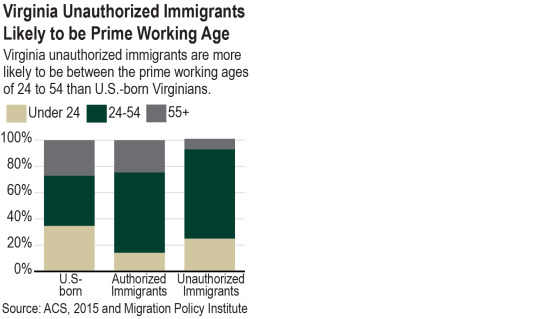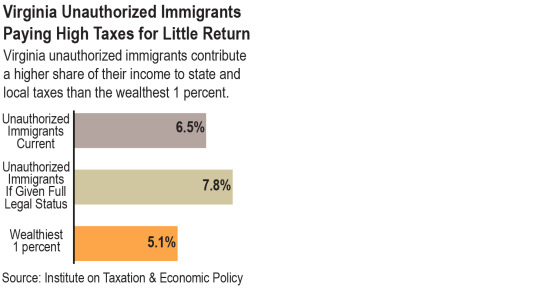April 24, 2017
Working, Paying Taxes, Hitting Barriers
Unauthorized immigrants in Virginia contribute more than $250 million each year in state and local taxes. That’s a lot of money. But they could contribute even more – nearly $100 million more – if they received lawful work permits and relief from fear of immigration enforcement, policy changes lawmakers could begin to address for the benefit of all.
Unauthorized immigrants in Virginia have the third highest household income average of all states and the District of Columbia, and higher workforce participation rates than the state’s U.S.-born or authorized immigrant residents. In addition, unauthorized Virginia immigrants are much more likely than the state’s U.S.-born residents to be in their prime working ages – 68 percent are between the ages of 25 to 54.

Despite paying taxes, unauthorized immigrants are not offered many of the social services that their taxes pay for. Essential safety net services such as Medicaid or the Earned Income Tax Credit, are not offered to unauthorized immigrants in any form, with very few exceptions. Furthermore, unauthorized immigrants in Virginia also pay a higher share of their incomes in state and local taxes than the wealthiest 1 percent of Virginians.

Additionally, these immigrants are not accessing higher educational opportunities at the same rate as other groups. While 24 percent of unauthorized immigrants in Virginia have received a bachelor’s degree or higher, compared to around 30 percent of the U.S. population at large, this rate is well below the state average for both U.S.-born and authorized immigrant state residents. This reduces the “cost” to the public of these state residents, but also likely reduces incomes and tax contributions.
For a number of reasons, including not having access to essential services paid for through their taxes and misclassification committed by employers, unauthorized immigrants in Virginia are significantly more likely to lack health insurance – nearly 58 percent of the population is uninsured, compared to 8 percent of the state’s U.S.-born population. When people do not have access to health coverage, they are more likely to have to take off additional days from work, have trouble maintaining a job, and have lower productivity when at work.
So what does all this data mean? It’s clear that unauthorized immigrants in Virginia are our friends, neighbors, and family. Almost half of the population has lived in the U.S. for 10 or more years. Many have fled violence in their countries of origin, married U.S. citizens since arrival, or had U.S.-born children. Addressing the challenges facing Virginia’s unauthorized immigrants head on could help nurture this young and hardworking population and allow them to more fully contribute to the state’s economy and workforce. At the national level, developing pathways for these families and individuals to become citizens would help deal with many of the root problems facing this community. In the meantime, improving access to health care and health services, cracking down on misclassification, and enhancing educational opportunities could go a long way towards cultivating a more productive Virginia workforce.
Category:
Immigration
